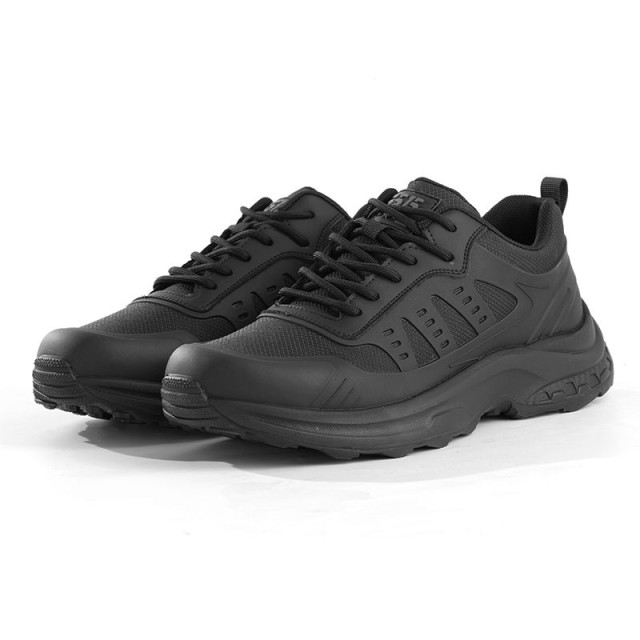Modern work boots do more than protect feet from sudden impacts—they're engineered to prevent chronic physical strain through biomechanically optimized designs. This article examines how leading manufacturers integrate safety features with ergonomic principles to create footwear that supports workers through long shifts.
The Science of Support
How Steel Toes Reduce Foot Fatigue (Not Just Impact)
While steel toe caps are renowned for protecting against falling objects, their structural benefits extend to reducing muscle fatigue. The rigid toe box:
- Distributes weight evenly across the footbed
- Minimizes micro-adjustments in toe positioning during movement
- Works with the shank to maintain natural foot alignment
Research shows composite safety toes offer comparable protection while being about 30% lighter than steel—a crucial advantage for workers in extreme temperatures where metal conducts heat or cold.
Slip-Resistant Outsoles and Their Role in Natural Movement
Slips cause nearly 20% of workplace injuries, but advanced outsoles do more than prevent falls:
- Oil-resistant rubber compounds maintain traction without compromising flexibility
- Multi-directional tread patterns reduce lateral strain on ankles and knees
- Shock-absorbing properties decrease impact forces traveling up the legs
In oilfield environments, TPU (thermoplastic polyurethane) soles outperform standard materials by resisting abrasion while maintaining grip on slick surfaces.
Ergonomics Beyond the Basics
Midsole Cushioning vs. Arch Support: Balancing Impact Absorption
The misconception that thicker cushioning equals better comfort can actually increase fatigue. Effective designs use:
- Dual-density midsoles: Firmer heel zones for stability transitioning to forefoot cushioning
- Contoured footbeds that adapt to high/low arches without overcorrecting
- Rebound materials that return energy with each step
Have you noticed how improper arch support can cause knee pain after long shifts? This stems from kinetic chain misalignment that quality boots actively prevent.
Breathable Safety: Moisture-Wicking Liners in Waterproof Boots
Waterproof membranes often trap heat, but modern liners solve this through:
- Hydrophobic mesh layers that move sweat away from skin
- Vapor-permeable membranes allowing airflow without compromising liquid barrier
- Antimicrobial treatments preventing odor-causing bacteria
These technologies create microclimates that reduce blister risks during 10+ hour wear.
Industry Proof Points
Case Study: Warehouse Workers’ 30% Reduction in Lower Back Pain
A logistics company reported significant improvements after switching to boots with:
- Metatarsal guards that reduced compensatory movements
- Rockered soles promoting proper gait cycles
- Wide toe boxes eliminating cramped toe positioning
Workers averaged 2,000 fewer steps per shift due to reduced "stutter stepping" on slick floors.
ASTM Standards That Mandate Comfort-Driven Safety
The ASTM F2413-18 standard goes beyond impact resistance to include:
- Compression resistance thresholds that influence midsole thickness
- Electrical hazard protection requiring non-conductive materials
- Puncture resistance affecting shank design and flexibility balance
These requirements ensure safety features enhance rather than hinder mobility.
Ready to experience work footwear engineered for all-day performance? 3515 partners with distributors and brands to deliver scientifically validated boots combining OSHA-compliant protection with ergonomic comfort technologies. Our manufacturing expertise transforms biomechanical research into real-world solutions for your workforce.
Products You Might Be Looking For:
Explore ergonomic steel toe work boots
View durable safety boots with steel toes
Check out customizable safety work boots
Browse high-quality steel toe safety boots
Related Products
- Wholesale Customizable Suede Safety Boots - Puncture-Proof with Velcro Closure
- Puncture-Resistant Velcro Safety Boots for Wholesale & Custom Manufacturing
- Customizable Anti-Smash Safety Boots for Wholesale & Private Label Manufacturing
- Athletic Safety Shoes with Dial Closure & Steel Toe for Wholesale & Custom Manufacturing
- Wholesale Classic Leather Lace-Up Ankle Boots for Brand Manufacturing
Related Articles
- Work Boots vs. Western Boots: How to Choose the Right Footwear for Labor Safety
- How to Choose Work Boots That Match Your Industry's Safety Needs
- Matching Men’s Work Shoe Safety Technologies to Workplace Hazards
- How to Extend Work Boot Lifespan: Science-Backed Care for Safety & Savings
- How to Choose Work Boots That Match Your Job Demands and Safety Needs



















